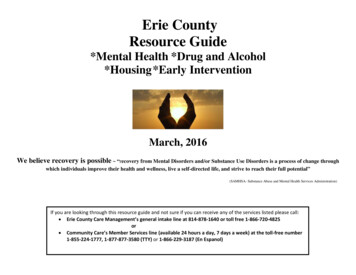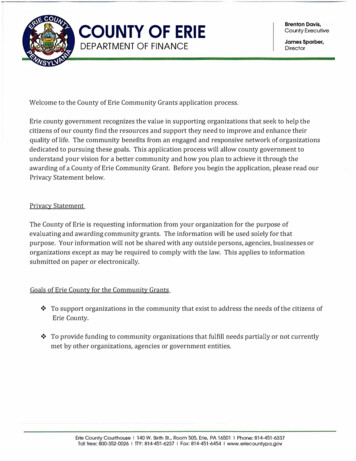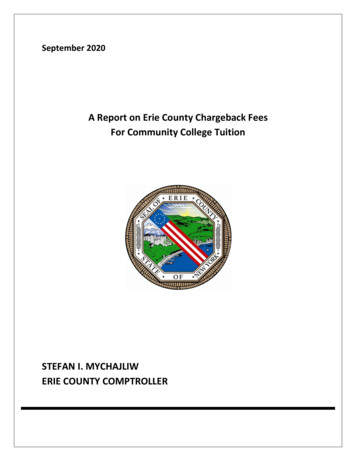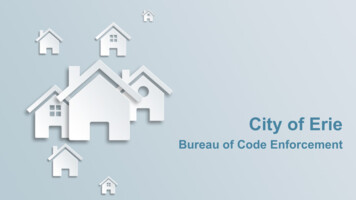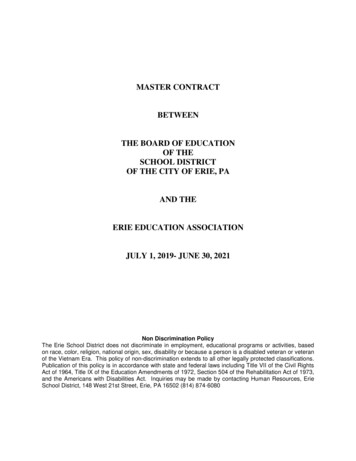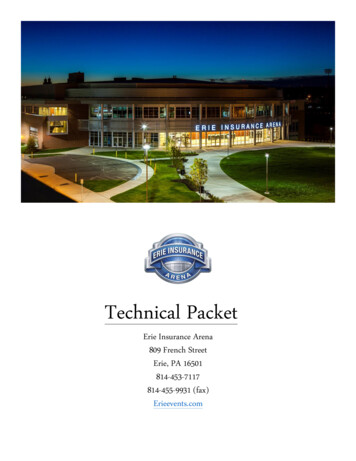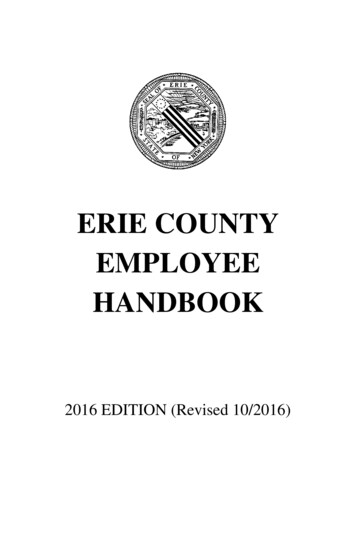
Transcription
ERIE COUNTYEMPLOYEEHANDBOOK2016 EDITION (Revised 10/2016)
Dear County Employee:Your appointment to your position as an Erie County employeecarries with it certain duties, responsibilities, rights and privileges. ThisEmployee Handbook is designed to inform you in detail of many of thepersonnel policies and procedures that apply to all County employees. Iurge you to read this Handbook thoroughly. It is designed to help you tobe more successful in your job.We are pleased you have joined our team and wish you arewarding and fulfilling public service career.SincerelyMARK POLONCARZCounty ExecutiveEDWARD A. RATH COUNTY OFFICE BUILDING95 FRANKLIN STREET, BUFFALO, NEW YORK14202i
TABLE OF CONTENTSINTRODUCTION . 1FOREWORD . 2PURPOSE . 2ERIE COUNTY AND ITS GOVERNMENT . 3BACKGROUND . 4MEETING THE PUBLIC . 4RESIDENCY . 5CODE OF ETHICS . 5IDENTIFICATION CARDS . 6EMPLOYEE ASSISTANCE PROGRAM . 6DIRECT DEPOSIT . 6FLEXIBLE BENEFITS . 7TELEPHONES . 7CELLULAR PHONES . 7POLITICAL ACTIVITY . 8AGENCY SHOP . 8PERSONNEL FILES. 8ERIE COUNTY EQUAL EMPLOYMENT OPPORTUNITY OFFICE . 9HARASSMENT POLICY OF ERIE COUNTY . 9WORKPLACE VIOLENCE POLICY . 15FAMILY AND MEDICAL LEAVE ACT OF 1993 . 15AMERICANS WITH DISABILITIES ACT AND NEW YORKEXECUTIVE LAW . 18PHYSICAL EXAMINATIONS . 19SALARY PLAN . 19MERIT INCREMENTS . 20PAY DAYS . 21EMERGENCY & TEMPORARY ASSIGNMENTS . 21PROMOTIONS . 21REASSIGNMENT WITHIN TITLE AND GRADE . 21PROBATIONARY TERMS . 22ATTENDANCE & RECORDING ATTENDANCE . 23COMPENSATORY TIME POLICY . 23TARDINESS POLICY . 24ii
FLEXIBLE TIME AT START OF SHIFT . 24EMERGENCY CLOSINGS . 24REMOVAL AND OTHER DISCIPLINARY ACTION . 25RULES . 25GROUP A . 25GROUP B . 27GROUP C . 28EMPLOYEE BENEFITS . 29HEALTH, HOSPITALIZATION AND DENTAL INSURANCE . 29NOTIFICATION PROCEDURE . 31DENTAL INSURANCE . 32WAIVERS OF BENEFITS . 32FEDERAL COBRA MEDICAL/DENTAL INSURANCE LAW . 33VACATIONS . 34PERSONAL LEAVE. 35SICK LEAVE . 35CALL-IN PROCEDURES TO REPORT NECESSARY ABSENCEFROM WORK . 36ABUSE OF SICK LEAVE . 37MATERNITY LEAVE . 38EXTENDED SICK LEAVE . 39CANCER SCREENING . 40SAFETY AND HEALTH. 40ON THE JOB INJURY . 42LEAVES OF ABSENCE WITHOUT PAY (GENERAL) . 43MILITARY LEAVE OF ABSENCE . 43VETERANS EDUCATIONAL LEAVE . 43LEAVES WITHOUT PAY FOR OTHER REASONS . 44RETIREMENT BENEFITS . 44BEREAVEMENT LEAVE . 46LEAVE FOR JURY DUTY . 46UNEMPLOYMENT INSURANCE . 46TRAVEL EXPENSES . 47COMPUTER INFORMATION SECURITY . 47INTERNET ACCESS POLICY . 48E-MAIL POLICY . 48iii
BLOOD DONATION POLICY . 49SMOKING POLICY . 49DRUG FREE WORKPLACE . 49DUAL EMPLOYMENT . 50CLASSIFIED RULES . 50COMPETITIVE CLASS TRANSFER . 50LAY-OFF/RETRENCHMENT FOR COMPETITIVE CLASSPOSITIONS . 51COMPETITIVE CLASS PREFERRED LISTS RESULTING FROMLAY-OFF . 52RESIGNATIONS . 54REINSTATEMENT . 54iv
INTRODUCTIONThis 2010 edition of the Erie County Employee Handbook supersedesany previous handbooks. The policies, procedures, and rules describedin this Handbook are subject to change, modification, or suspension atthe County’s discretion and with the approval of the Erie CountyLegislature and/or the agreement of Erie County labor bargaining units,as required. New policies, procedures, and rules will be disseminated tothe holders of this Handbook, as applicable.This Handbook is not intended to be comprehensive or to address allCounty policies or all the possible applications of, or exceptions to, thepolicies, procedures, and rules described herein. If, after reviewing thisHandbook, employees have any further questions concerning eligibilityfor a particular benefit, or the applicability of a policy, procedure, orrule, they should first consult the Erie County Personnel Policies andProcedures Manual (available on Sharepoint) and their collectivebargaining agreement, if applicable. Remaining questions and/or issuesrequiring further clarification should be addressed with the Erie CountyPersonnel Department.The Erie County Handbook does not provide employees with additionalrights not provided by any applicable collective bargaining agreement orlaw.8/2010; Rev. 9/2015, 10/20161
FOREWORDTo those of you first entering public service with Erie County,Welcome!To our present employees, many thanks for your hard work anddedication in helping to provide the varied and necessary services to thecitizens of Erie County.We sincerely hope that each of you finds with Erie County theopportunities and challenges that will provide for your personal andprofessional growth.PURPOSEThis handbook is furnished to provide an introduction to Countyemployment, to summarize briefly what you may expect from employmentwith Erie County and some of the things your department will expect of you. Itis also meant to answer some of the more common questions asked by bothnewer and more established employees in County service. Hopefully this bookwill direct you to the offices and sources most likely to provide answers toother questions that may arise during the course of your employment.This book is also available on the Erie County SharePoint intranet site.NOTE: PLEASE SAVE THIS HANDBOOK FOR READY REFERENCE ONQUESTIONS THAT MAY ARISE CONCERNING COVERED ASPECTS OFYOUR EMPLOYMENT.2
ERIE COUNTY AND ITS GOVERNMENTErie County, New York, came into being on April 21, 1821, with thedivision of the then Niagara County into two parts: the present Erie and NiagaraCounties.* Legally, Erie County is a municipal corporation. It was one of thefirst in the State to adopt a Home Rule Charter with a strong elective form ofgovernment. The offices of Comptroller, District Attorney, Sheriff and CountyClerk are elective, as is that of the County Executive. In March, 1967, thevoters approved an amendment to the Charter which divided the County intotwenty equally-populated districts, and created a County Legislature composedof a Legislator from each of the districts. Since 2012, the number of legislatorshas been reduced to 11. The Legislators are elected for two-year terms in oddnumbered years. The duties of the Legislature include making appropriations,levying taxes and incurring indebtedness, confirming certain appointmentsmade by the County Executive, as well as other various duties andresponsibilities. The County Executive is elected from the County at large for afour-year term, and is the Chief Executive officer and Administrative Head ofthe County Government.The County Executive appoints to serve at his pleasure heads of everydepartment, administrative unit and agency, as well as the officers andemployees in his own office.Erie County is a charter form of government. The present Erie CountyCharter was first adopted in 1959. It defines the general functions andorganization of the County, and provides for an elected County Executive,Comptroller, Board of Supervisors, and the District Attorney, Sheriff andCounty Clerk. The stated purposes of the Charter are to maximize Home Ruleand the efficiency of the government, and to separate clearly the administrativeand legislative functions of government.In 1960, the Board of Supervisors adopted an Administrative Codewhich sets forth the details of administration in the County. This code providesrules governing the duties of the offices, institutions and departments of theCounty and ways in which these duties shall be carried out. It prescribes, forexample, the manner in which the County Executive appoints departmentheads.*Some of this material is taken from ERIE COUNTY, a study by the League of Women Voters.3
BACKGROUNDUnlike businesses in the private sector, government has no owner orowners. Government is owned by and represents all people. Therefore, ingovernment, every person is an employee who is elected, appointed or hired toperform a specific job or function.Many of the conditions and procedures that cover our employment arespecifically authorized or required by Law, statute or collective bargainingagreement. Examples include, but are not limited to, the New York State CivilService Law; New York State Public Officers Law; New York State GeneralMunicipal Law; County Law; “The Rules for the Classified Service of ErieCounty.,” which has the force and effect of law; the Erie County Charter; theErie County Administrative Code; and other state and federal laws that apply toall employment, both public and private.Laws, statutes and work rules change over a period of time. For thesereasons this handbook is specifically meant only to supplement these othersources. Anything contained herein that might inadvertently be in conflict withany law, statute, or labor agreement will be void. In case of a conflict, theapplicable legal source will take precedence. By the same token, this handbookdoes not grant any employee, whether “at will” or union, with any rights otherthan those provided by New York State or Federal laws.MEETING THE PUBLICThe public views the quality of County services by the courtesy andefficiency shown to them by the County employees with whom they come indirect contact. The public supports our services with their taxes, and our job isto provide them with the services they need. The public has every right to betreated with courtesy and respect, and to expect appropriateness in dress andmanner from each of us.In performing your job, you may come in contact with a person who isdiscourteous for a variety of reasons. Most often he or she may not understandwhy something cannot be done, or in other cases why something must be done.A most important aspect of your job is to be as polite and helpful as possible inspite of any such occasional difficulty.4
RESIDENCYAn applicant for original appointment to County service must be a legalresident of Erie County for at least one month immediately preceding the dateof examination and must be legal residents of Erie County at the time ofappointment. The Commissioner of Personnel may make exception to thisrequirement for situations where qualified applicants cannot be found withinthe County. Erie County residence is not required for promotional appointmentor for competitive class promotional exams.CODE OF ETHICSIn 1989, the County Legislature passed an updated Code of Ethics bypassing Local Law l0-1989. The Law was amended in 1994 by Local Law 41994.The following individuals must file: All elected officials, departmentheads, heads of administrative boards including members of: Sewer DistrictBoard of Managers, ECMC Board Members, Community College BoardMembers, Library Board Members, Chairman of County committees ofpolitical parties, Candidates for elective County office and all employees in apolicy-making position in County government.Policymaking employees include all deputies to the County Executiveor a department or division (but not a deputy sheriff), the assistant to a head ofa department or administrative unit, and other employees who through theirregular duties are able to make County policy.Examples of employees in policy-making positions are those who areauthorized to commit the County to a binding agreement, such as a contract, orhold regulatory authority over private interests. It is the responsibility for eachdepartment head to determine which employees in his/her unit are required tofile the ethics disclosure form.All persons subject to file disclosure forms must do so by May 15th.PROHIBITED ACTIVITIES: Under Local Law 10-1989 as amendedby Local Law 4-1994, no elected official, County officer or employee shall:directly or indirectly solicit any gift, or accept or receive any gift having avalue of seventy-five dollars or more, whether in the form of money,service, loan, travel, entertainment, hospitality, thing or promise, or inany other form under circumstances in which it could reasonably be5
inferred that the gift was intended to influence him, or could reasonablybe expected to influence him in the performance of his official duties, orwas intended as a reward for any official action on his part;Other prohibited activities are listed under the local law.IDENTIFICATION CARDSAn identification card has been issued to all County employees.Employees are expected to wear their identification card at or above the waist,and present it upon legitimate request. Identification cards will be used forswiping in and out of work at the time clocks and for designated door access. Ifthe identification card is lost, it is the responsibility of the employee to obtain areplacement. Identification cards must be returned when an employee leavesCounty service.EMPLOYEE ASSISTANCE PROGRAMErie County has contracted with a private firm to provide assistance toemployees who are experiencing personal problems.The Employee Assistance Program (EAP) provides comprehensivecounseling and referral to County employees who seek assistance for a varietyof personal reasons. All employee requests for assistance are handled in asensitive and confidential manner.If you are experiencing personal problems related to drug or alcoholabuse or other personal or financial problems that are affecting your work orpersonal relationships with family, friends and/or co-workers, you areencouraged to contact the EAP Contact information can be found on the ErieCounty Sharepoint Intranet site or in the Personnel Department. Yourparticipation in this program will be kept strictly confidential.DIRECT DEPOSITThe County offers a direct deposit program for all employees. Theprogram allows employees to directly deposit their paycheck into any ABAparticipating bank or credit union in the United States (maximum of fivebanks). Check with your department payroll division for more information.6
FLEXIBLE BENEFITSEmployees may participate in a Flexible Benefits Program approvedunder Sections 125 and 132 of the Internal Revenue Code. This program allowsemployees to reduce their Federal, State and Social Security tax bases formiscellaneous qualified medical, dependent care, adoption, health/disabilitypremium, and parking expenses, by using pretax dollars to cover theseexpenses. There are limits on the amounts that employees can reduce their taxbase and employees should contact the Personnel Department for furtherinformation. Employees can make pre-tax deductions for qualified medical,dependent care expenses and up. Health insurance premiums paid by employeesmay also qualify under the plan. Enrollment forms are distributed to allemployees in November of each year.TELEPHONESBusiness phones are absolutely necessary for the conduct of publicbusiness. They are to be used with discretion, not abused. Employees shouldlimit their calls to the conduct of County business. Personal calls into, or out ofthe County or between County departments are prohibited.Emergencies such as illness or death of a family member, etc., mayrequire your receiving immediate telephone notification. Such obviousemergency situations are not considered personal calls under this rule.CELLULAR PHONESCellular phones that are issued by the County are to be used for Countybusiness. Usage of County provided cellular telephones should follow the sameguidelines as stated in the policy for landline desk phones issued by the County.Personal cellular phones should be kept out of sight, and used only foremergencies or on breaks or lunches. Personal cellular phones should not beused on County time; this includes both talking and text messaging. Ringtonesshould be kept on silent in order to avoid disruptions.7
POLITICAL ACTIVITYThere is often confusion about the political restrictions on publicemployees. The laws which limit political activity are a Federal Law known asthe Hatch Act as well as certain provisions of the New York Labor Law. TheHatch Act applies to local government employees whose activities are largelyfunded by the Federal government or to employees who work in connectionwith a federally funded activity. For example, the Hatch Act applies to allemployees of the Department of Social Services, and anyone whose salary ispaid through a grant provided by the Federal government. Many of the earlierrestrictions provided by the Hatch Act have been removed. The followingremain: Covered employees may not be candidates for any elective office in apartisan election, and they also may not use official authority for the purpose ofinterfering with or affecting the result of an election.Employees whose employment is covered by the Hatch Act must resigntheir positions if they decide to become a candidate for elective office. Furtherinformation regarding the Hatch Act can be found atwww.osc.gov/hatchact.htm.AGENCY SHOPThe Public Employees Fair Employment Act (the Taylor Law)specifically prohibits any requirement that an employee must become a memberof any labor organization. However, provisions of a state law passed in l978permits Agency Shop provisions to be written into labor contracts.The contents of an employees personnel file are governed by New YorkState and Federal Laws, as well as any collective bargaining agreement if theemployee is a member of a union.Agency Shop provisions are included in all Erie County bargainingagreements.PERSONNEL FILESIndividual personnel files are maintained for each County employee.Contained in these files are copies of the necessary data, forms, evaluations,records, etc., relating to their employment.8
The contents of an employee’s personnel file are governed by NewYork State and Federal Laws, as well as any collective bargaining agreement ifthe employee is a member of a union.ERIE COUNTY EQUAL EMPLOYMENTOPPORTUNITY OFFICEIt is Erie County’s policy to provide Equal Employment Opportunity inevery aspect of employment to all applicants and employees including Vietnamera and disabled veterans, without regard to age, race, creed, color, nationalorigin, sexual orientation, military status, sex, disability, predisposing geneticcharacteristics, marital status, or domestic violence victim’s status, and anyother basis protected by New York State or Federal Laws. In an attempt toreaffirm, strengthen and reinforce its commitment to this policy, the County hasdeveloped a positive, continuing program known as the Affirmative ActionPlan for Equal Employment Opportunity.The County Equal Employment Opportunity Office (EEO) wasestablished in 1974 in accordance with Title VII of the Civil Rights Act of 1964as amended by the Equal Employment Opportunity Act of 1972. One of theoffice’s primary purposes is to assure that all persons in County government aretreated equally in employment matters such as hiring, transfer, layoff,termination, promotion or recall.Any person who believes that his or her rights have been wrongfullydenied for any of the reasons listed above, should contact the EEO Office forcounseling at 858-7542 or at www.erie.gov/depts/eeo. Should you wish to file acomplaint of discrimination, you should contact the EEO office at 858-7542 orat www.erie.gov/depts/eeo. The office will fully investigate your complaint, adetermination will be made, and corrective action initiated where warranted.HARASSMENT POLICY OF ERIE COUNTYI. Statement of PhilosophyThe County of Erie is committed to maintaining a work environment free ofunlawful discrimination and harassment, and will not tolerate harassment ofits employees by any supervisor, coworker, patient, vendor, client, or anyother person.9
In accordance with applicable law, the County of Erie prohibits all forms ofharassment which includes any unwelcome conduct, whether verbal,physical, or visual, that is based upon a person's gender, race, color, nationalorigin, ancestry, religion, creed, physical or mental disability, marital status,age, sexual orientation, genetic predisposition, military status, domesticviolence victim status or any other basis protected by federal, state or locallaw. Such conduct is unlawful and prohibited whenever it affects tangiblejob benefits, unreasonably interferes with an individual's work performance,or creates an intimidating, hostile, or offensive working environment.II. Forms of HarassmentSexual harassment consists of unwelcome sexual advances, requests forsexual favors, and other verbal, visual, and physical conduct of a sexualnature whenever:1. Submission to the conduct is made either an explicit or implicitcondition of employment;2. Submission to or rejection of the conduct is used as the basis for anemployment decision affecting the harassed employee; or3. The harassing conduct unreasonably interferes with an employee's workperformance or creates an intimidating, hostile, or offensive workingenvironment.Sexual harassment can involve an almost infinite variety of conduct and canoccur between individuals of the same sex. Some examples include:1. Unwelcome physical contact with sexual overtones, such as touching,patting, pinching, repeatedly "brushing" against someone, or impedingthe movement of another person2. Sexually offensive comments such as slurs, jokes, epithets, andinnuendos3. Sexually oriented "kidding" or "teasing," or sexually oriented "practicaljokes"4. Suggestive or obscene written comments in notes, letters, invitations, ore-mail5. Inappropriate, repeated, or unwelcome sexual flirtations, advances, orpropositions6. Offensive visual contact such as staring, leering, gestures, or displayingobscene objects, pictures, or cartoons10
7. Inappropriate or suggestive comments about another person's physicalappearance or dress8. Exchanging or offering to exchange any kind of employment benefit fora sexual concession, e.g., promising a promotion or raise in exchangefor sexual favors9. Withdrawing or threatening the withdrawal of any kind of employmentbenefit for refusing to grant a sexual favor, e.g., suggesting that anindividual will receive a poor performance review or be denied a raiseunless she [he] goes out on a date with a supervisor10. Any action taken because of individual's gender that alters the terms,conditions or privileges of employment.Some other examples of prohibited harassment include:1. Offensive comments such as racial or ethnic slurs, jokes, epithets, andinnuendos.2. Conduct oriented "kidding" or "teasing," or "practical jokes" based on aperson’s race, color, national origin, ancestry, religion, creed, physicalor mental disability, marital status, age, sexual orientation, geneticpredisposition, military status, domestic violence victim status or anyother basis protected by federal, state or local law.3. Harassing conduct based on gender, race, color, national origin,ancestry, religion, creed, physical or mental disability, marital status,age, sexual orientation, genetic predisposition, or military status,domestic violence victim status or any other basis protected by federal,state or local law that unreasonably interferes with an employee's workperformance or creates an intimidating, hostile, or offensive workingenvironment.4. Any action taken because of individual's gender, race, color, nationalorigin, ancestry, religion, creed, physical or mental disability, maritalstatus, age, sexual orientation, genetic predisposition, or any other basisprotected by federal, state or local law that alters the terms, conditionsor privileges of employment.III. Applicability of PolicyThe prohibition against harassment applies to everyone -- managers,supervisors, salaried and hourly workers, temporary employees, contractors,customers, patients, suppliers, visitors, guests, elected officials andappointed administrative officials. The County of Erie will not tolerateharassment of any kind by anyone.11
IV. Reporting Illegal HarassmentWhile the County encourages individuals who believe they are beingharassed to firmly and promptly notify the offender that his or her behavioris unwelcome, the County also recognizes that such a confrontation may beuncomfortable or even impossible. In the event that such informal, directcommunication between individuals cannot be accomplished for any reason,or is ineffective or inappropriate given the circumstances or severity of thesituation, the following steps should be taken to file a formal harassmentcomplaint:1. Notify Appropriate StaffIndividuals who believe they have been sexually harassed or subject toharassment because of race, color, national origin, ancestry, religion, creed,physical or mental disability, marital status, age, sexual orientation, geneticpredisposition, military status, domestic violence victim status, or any otherbasis protected by federal, state or local law, should immediately report theincident to his or her direct supervisor. If the supervisor is the allegedharasser or the employee is uncomfortable reporting the alleged harassmentto his or her supervisor, the incident should be reported directly to his or herDepartment Head. In the event that the circumstances of the situation makeit inappropriate to report the incident should the individual's supervisor or tohis or her Department Head, the incident should be reported to anotherDepartment Head or
ERIE COUNTY AND ITS GOVERNMENT Erie County, New York, came into being on April 21, 1821, with the division of the then Niagara County into two parts: the present Erie and Niagara Counties.* Legally, Erie County is a municipal corporation. It was one of the first in the State to adopt a Home Rule Charter with a strong elective form of government.
